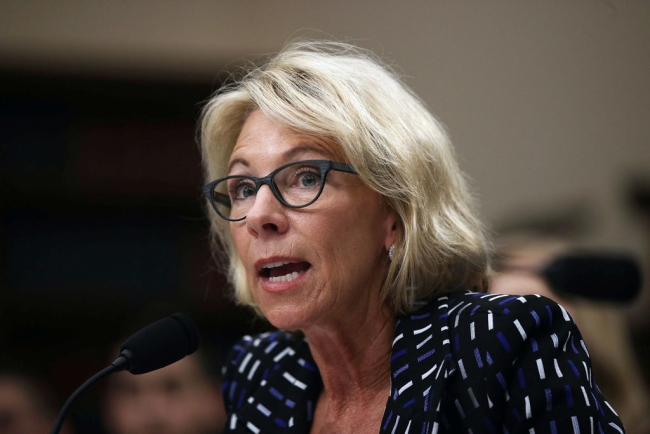You have /5 articles left.
Sign up for a free account or log in.

Education Secretary Betsy DeVos testifying to House appropriators.
Getty Images
Last week the U.S. Department of Education published in the Federal Register its intention to repeal the gainful-employment regulations established in 2014. Those regulations were designed to ensure that predatory for-profit institutions could not bilk both unsuspecting students and taxpayers by providing costly vocational training that resulted in high student debt and little chance for employment. The 30-day opportunity for public comment on the proposed change ends Sept. 13.
So why the change now? The ostensible reason is questions about the validity of the debt-to-earnings ratio used as a metric to identify institutions producing high levels of student debt compared to earnings. Gainful-employment programs (defined as nondegree programs at nonprofit institutions and all for-profit programs) risk their eligibility for federal Title IV student aid funds if their graduates’ student loan debt exceeds a certain percentage of their income. The Education Department is arguing that research findings in the four years since the advent of gainful employment call into question the debt-to-earnings ratio as a proxy for quality or performance.
Occam’s razor is a well-known philosophical principle that the simplest explanation for an event is usually the correct explanation, and in this instance Occam would conclude that the primary motivation is to overturn a policy of the Obama administration. Or is this an example of the Seinfeldian “Bizarro World” we seem to inhabit, a world where Canada and Germany are our enemies and Russia our friend, where the administration is concerned about the National Association for College Admission Counseling's Statement of Principles of Good Practice but not for-profit college practices?
The end of gainful-employment rules may also represent the revenge of the for-profit college sector, which was the primary target of the regulations. The finances and practices of for-profits have received serious scrutiny, from its dependence on federal funds to its use of high-pressure sales techniques. Secretary of Education Betsy DeVos’s senior staff includes several former for-profit administrators, and of course one former for-profit bears the name of a prominent member of the Trump administration, so the for-profit sector now has multiple seats at the higher education policy table.
The Department of Education is proposing that gainful-employment requirements be ended and replaced by an expanded College Scorecard or a similar website with information on mean salaries and debt loads for all institutions. That raises questions about how accurate and meaningful the information on the scorecard is and how effective the scorecard has been in helping consumers compare educational options.
The Education Department is presenting this as a transparency issue, providing more complete information for consumers, or an equity issue, treating all postsecondary institutions alike regardless of whether they are for-profit or nonprofit. In the announcement of the intent to abolish gainful employment, there are hints that the department believes that for-profit institutions are being profiled. Page 40 of the notice of proposed rule making even tries to claim moral equivalence similar to the “Both sides are to blame” argument used by President Trump after last August’s events in Charlottesville, Va., citing incidents ranging from misreported information to U.S. News to the fake classes scandal at the University of North Carolina at Chapel Hill as evidence that “bad acts occur among institutions regardless of their tax status.”
But is that really the issue? The gainful-employment regulations were established to respond to evidence that fraud, misrepresentation and unethical behavior were pervasive within the for-profit sector of higher education. That is not to say that all for-profit institutions are taking advantage of students and taxpayers, of course, but the industry included a lot of bad actors. A 2010 government study found that every one of the 15 for-profit colleges where undercover agents posed as prospective students made deceptive claims, with four encouraging fraudulent behavior.
The largest revenue stream by far received by for-profit institutions comes from federal sources, including Pell Grants and federal loans, totaling $30 billion annually. And that figure doesn’t include veterans’ benefits. The government’s primary concern should be consumer protection from fraudulent claims and practices and protection for taxpayers from abuse of federal funds.
It is estimated that the for-profit sector accounts for 13 percent of the postsecondary student population and 18 percent of federal student loans but nearly half of all federal student loan defaults. A report issued last November by the Century Foundation based on a Freedom of Information Act request found that of the nearly 100,000 borrower-defense claims made to the federal government for loan relief by students claiming fraud or misrepresentation from an institution, 98.6 percent (or all but 1,300) were from for-profit institutions. Three-quarters of those claims were against one entity, the now out-of-business Corinthian Colleges, but 94 percent of the remaining claims involved the for-profit sector. Under Secretary DeVos, the Education Department has slowed investigation of borrower-defense claims, and the Century Foundation report indicated that as of last November there was a backlog of 87,000 complaints.
The argument for reducing regulation is usually tied to reducing the reporting burden and also to saving money. Ending gainful employment will in theory ease the reporting burden for institutions, although if the alternative is collecting and reporting debt-to-earnings for all institutions on College Scorecard, the regulatory burden will be increased. So will the cost to taxpayers. The Education Department's own analysis predicts that repealing the regulations will cost taxpayers $5.3 billion over the next decade. The unanswered question is who benefits from those funds.
Regardless of what happens, there is a more important issue that won’t disappear. In all fairness, the for-profit sector has risen and grown to meet, or at least exploit, a market need. It attracts, and hopefully sometimes serves, students that traditional nonprofit colleges and universities haven’t served or wanted to serve. Gainful employment was designed to identify and hold accountable institutions that are predatory. With or without gainful-employment regulations, we have to ensure that there are educational and vocational training paths available to nontraditional students, and we can’t allow that space to be taken over by those who want to take advantage of rather than help those students.








